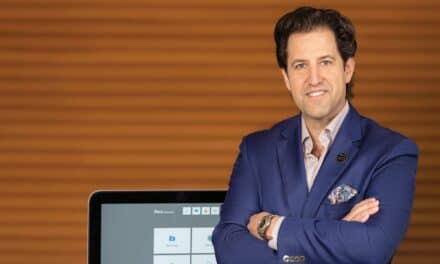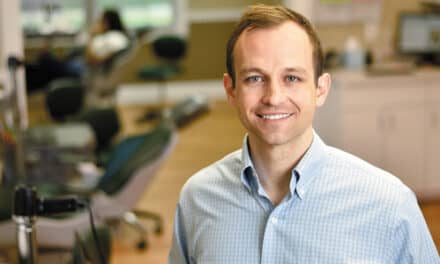By Alison Werner | Photography by Charles Beaver
At 17, Robert Rudman, DDS, MS, was touring the country in a successful rock band as a guitarist. At 24, he was selling the transportation service business he had started with a friend at 18 to an investment group and returning to college to finish a business degree. By 26, he was in dental school looking ahead to a career in orthodontics. Not the typical path one takes to carve out a successful career as an orthodontist.
The Orthodontist
After graduating from Marquette University School of Dentistry in Milwaukee, Rudman started his orthodontic career in Minnesota, but after a few years he made the decision to move west. He settled on Denver as the place to develop his career, having enjoyed skiing and white water rafting there years earlier. There, he joined the practice of another orthodontist in Littleton, Colo, only days after the April 1999 shooting at Columbine High School that killed 12 students and one teacher. The practice, which was near the high school, saw an influx of students in the days after the shooting as their retainers were abandoned during the evacuation in the school, which was then under a lockdown by the FBI. “We were replacing everybody’s retainers frantically,” Rudman remembers. “You don’t really think about those small things when something like that happens.”
A year and a half later, Rudman had the opportunity to buy one of the two offices of that same orthodontist, allowing him to own his own full-time practice. Twelve years on, he has created a thriving practice, which serves the Denver and Stapleton areas.

The in-house lab allows Rudman and his staff to more efficiently treat patients. Two orthodontic assistants, who are dual trained to do lab and clinical work, staff the lab. “There is just a quicker turnaround on things,” Rudman says. “We can get a patient in one day and turn it around the next day.” And as he does indirect bonding exclusively, including phase I patients, the in-house lab provides more quality control, not to mention patient convenience.
The Early Adopter
Rudman is always looking for technology that allows him to improve his patients’ experience and treatment success. That drive led him to be an early adopter of AcceleDent. Manufactured by Houston-based OrthoAccel® Technologies Inc, AcceleDent is an appliance used by patients at home to accelerate orthodontic tooth movement, reducing treatment time with braces and clear aligners. He had first seen it in use while on a lecturing trip to Australia in 2009. “I got to talk to orthodontists there, and they were pretty impressed with what it was doing,” he says. Returning to Denver, Rudman educated himself about the device and readied himself for its eventual approval by the FDA. In fact, it was one of Rudman’s patients who was the first person in the United States to finish treatment using AcceleDent. The patient’s treatment time, originally estimated at 18 months, was completed in 10 months.
For Rudman, AcceleDent allows him to convince otherwise hesitant patients to commit to braces. “I think a lot of time adults come in and want to do something like Invisalign, and they’re not a good candidate for it. Their immediate response is, ‘I’m going to have to be in braces for 2 years.’ If I can put them down into a 12- to 15-month time frame, then they can deal with it. We can pursue a more ideal treatment when they know they have the option to be done faster.”
The Entrepreneur
| Practice Profile: Advanced Orthdontic Care |
|
Location: Denver Office square footage: 3,500 Years in practice: 12 Average patients per day: 80 Days worked per week: 3.5 Education: Marquette University School of Dentistry (DDS, MS) Top six products: AcceleDent, Synergy® R bracket system, iTero Digital Impression System, RMbond® Indirect Bonding System, Ormco Copper Niti, Ormco Insignia custom bracket system Website: cherrycreeksmiles.com |
But long before Rudman was thinking about ways to make orthodontic treatment more appealing to his patients and growing his orthodontic practice, he was thinking up ways to stand out from the crowd. Since childhood, Rudman has had an entrepreneurial spirit. At 8, he would fill a large trash can with sodas and take them down to the local park to sell. And as a young teen, he had a lawn-cutting business. So, teaming up with a friend in high school to start a company that serviced transportation equipment wasn’t so surprising. In fact, Rudman credits those early entrepreneurial endeavors, more than his college business degree, with the success of his practice.
“It gave me confidence and the knowledge to know you have to go out and drum up business.” It taught him the importance of marketing and how to manage a large staff. Today, Rudman relies on his staff of 11 to make his practice just as successful as his past pursuits. “I have an awesome team that I have complete confidence in, and I always empower them to use their skills to make our practice great.”
The Inventor
As Rudman got older, that entrepreneurial spirit grew into an inventive streak that has had him making his own contributions to the orthodontic field and better treatment options.
In 2006, he invented the Synergy® R bracket system, which combines the utility of a twin bracket and the benefits of a self-ligating bracket without moving parts. The posterior brackets, which all have a convertible cap, allow users to thread the wire so everything is frictionless in the back, while simultaneously allowing control of the front to be maintained. Rudman took the idea to Denver-based RMO (Rocky Mountain® Orthodontics), and Synergy R was born. The partnership also led to Rudman’s involvement in the development of the company’s RMbond® Indirect Bonding System.
And what motivates Rudman—who lectures on TADs, indirect bonding, practice efficiency, and complicated restorative cases around the world—to pursue these projects? First, a need to always find a better way to do something. And second, the realization that if someone else can invent something and patent it, then why can’t he. “I realized that anyone who makes an effort to do something can do it,” he says. “You realize that it doesn’t always take brains to do something, but rather a lot of hard work to get from point A to point B.”
The Rock Star

“All these guys were like 26 and 27 years old, and I was this 17-year-old kid. They would have to ask the clubs to let me in because I was too young to drink. The very first gig we played was at this high school—a cancer fund-raiser—and I signed autographs for 2 hours,” he recalls. Rudman stayed with the band for almost 3 years, traveling on the road.
“My parents loved it,” he says with a laugh. “I was dropping out of college every other month.” But he was making a living and playing venues like the Cotton Bowl and opening for the popular 1960s rock group Steppenwolf.
Eventually, it was his other pursuit—the transportation service business he’d started with his high school friend—that pulled him away from the rock star life. The business experienced phenomenal growth, and just like in his band years, it got in the way of college. However, by 21, he was enough of a success to be able to afford his own home.
“People would knock at the door and say, ‘Is your mom home?’ and I’d say, ‘This is my house,’ ” Rudman recalls. He admits that he was making way too much money as a young kid. But he managed to stay out of trouble. “Luckily, I had some kind of moral compass or I was just afraid my mom would show up and spank me.”
Rudman found himself on stage again during his orthodontics residency in Milwaukee in a band he started with a friend who was a chiropractor. They called themselves STAB (ie, Straight Teeth and Back) and played open mic nights at clubs throughout the city. While Rudman breaks out the guitar every once in a while now, he jokes that, “The only wires I’m plucking these days are the wires on people’s teeth, not the wires on a guitar.”
Rudman isn’t quick to share these stories of his past pursuits, but his stint as a rock star has become part of the fun had in his practice. “One time we had an open house, and my staff took a 20-year-old picture of me with long hair playing guitar and made a life-size version. We had a guitar, some wild outfits and a wig, and let the referring doctors and their staff who were there for the open house take pictures standing next to the cutout of me. It was a huge hit,” Rudman says, adding with a laugh, “Don’t ask me why.”
Now when kids who play instruments come into his office, he breaks out that original photo and has a laugh with them as they try to imagine him with the long hair he sports in the picture. The kids think it’s cool that the orthodontist working on their teeth was once on stage rocking out in front of thousands of screaming fans.
The Businessman

The strategy was intentional, Rudman says, and aimed at keeping his practice safe for the long term. “When you have an adult patient you generally get another adult as a referral. But when you have kids, you generally get the kid’s entire family, including the parents, and all their friends.”
To keep those families engaged, he offers free monitoring of patients’ younger siblings until they start treatment. In addition, his staff created the Smile Detective program for these future young patients. The program gives those future patients a kit that includes a badge with the child’s photo, a magnifying glass, and tooth brushing supplies. Once the child is ready to begin treatment, they receive a postcard with the Smile Detective theme that asks them a number of questions to which they have to search out the answers. The questions revolve around orthodontics, general oral health, and the practice itself. The child comes to their first appointment with the card, having put their “detective” skills to work. Rudman is proud of the program his staff created and how it engages the practice’s young patients early on.
Not only does Rudman strive to treat his patients like family, he strives—without much effort—to make sure they have a good time. “We like to have fun. We like to joke around,” he says. At the end of the day, it isn’t hard to imagine his patients leaving with a smile on their face. OP
Alison Werner is the editor of Orthodontic Products. She can be reached at [email protected].






